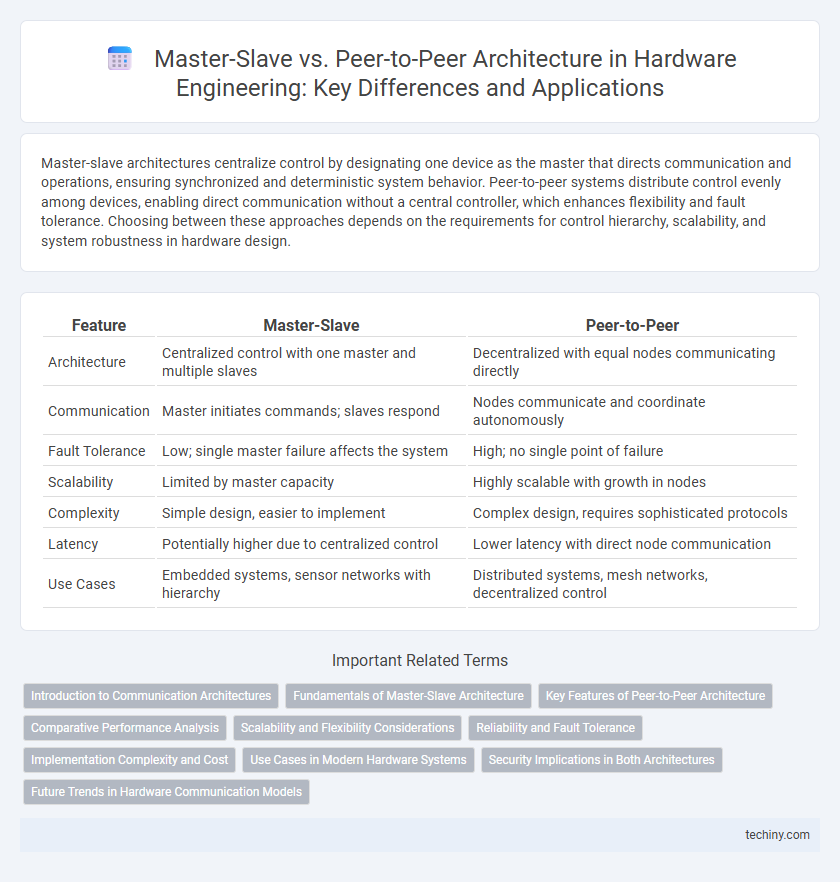Master-slave architectures centralize control by designating one device as the master that directs communication and operations, ensuring synchronized and deterministic system behavior. Peer-to-peer systems distribute control evenly among devices, enabling direct communication without a central controller, which enhances flexibility and fault tolerance. Choosing between these approaches depends on the requirements for control hierarchy, scalability, and system robustness in hardware design.
Table of Comparison
| Feature | Master-Slave | Peer-to-Peer |
|---|---|---|
| Architecture | Centralized control with one master and multiple slaves | Decentralized with equal nodes communicating directly |
| Communication | Master initiates commands; slaves respond | Nodes communicate and coordinate autonomously |
| Fault Tolerance | Low; single master failure affects the system | High; no single point of failure |
| Scalability | Limited by master capacity | Highly scalable with growth in nodes |
| Complexity | Simple design, easier to implement | Complex design, requires sophisticated protocols |
| Latency | Potentially higher due to centralized control | Lower latency with direct node communication |
| Use Cases | Embedded systems, sensor networks with hierarchy | Distributed systems, mesh networks, decentralized control |
Introduction to Communication Architectures
Master-slave communication architectures feature a central controller managing multiple subordinate devices, ensuring synchronized data exchange and simplified control flow. Peer-to-peer architectures enable direct, decentralized communication between nodes, enhancing scalability and fault tolerance in hardware systems. Understanding these fundamental architectures is critical for designing efficient communication protocols in hardware engineering.
Fundamentals of Master-Slave Architecture
Master-Slave architecture in hardware engineering organizes devices such that one master device controls one or multiple slave devices, enabling centralized management and synchronization. The master device issues commands and manages data flow, while slave devices respond and perform tasks based on the master's instructions. This architecture simplifies communication protocols and ensures deterministic timing, making it ideal for applications requiring coordinated control and precise sequencing.
Key Features of Peer-to-Peer Architecture
Peer-to-peer architecture enables direct communication between nodes without a centralized controller, enhancing system scalability and fault tolerance. Each node in the network can act as both a client and a server, facilitating distributed resource sharing and load balancing. This decentralized model improves redundancy and reduces bottlenecks compared to master-slave configurations.
Comparative Performance Analysis
Master-Slave architectures typically exhibit lower latency and simpler synchronization due to centralized control, which enhances deterministic performance in hardware systems. Peer-to-Peer models offer greater scalability and fault tolerance by enabling direct communication between nodes, reducing bottlenecks inherent in master nodes. Performance benchmarks reveal that Master-Slave excels in predictable timing-sensitive applications, while Peer-to-Peer architectures provide superior throughput and robustness in distributed hardware environments.
Scalability and Flexibility Considerations
Master-Slave architectures often face scalability limitations due to the centralized control that can become a bottleneck as the system grows, restricting concurrent operations and hindering flexibility in dynamic environments. Peer-to-Peer designs enhance scalability by enabling distributed control and direct communication among nodes, allowing more seamless integration of additional devices without centralized constraints. Flexibility is greater in Peer-to-Peer setups as they support decentralized reconfiguration and fault tolerance, whereas Master-Slave systems require rigid hierarchical adjustments to accommodate changes.
Reliability and Fault Tolerance
Master-Slave architectures offer predictable control and easier fault isolation, enhancing reliability through centralized error detection and management. Peer-to-Peer systems improve fault tolerance by distributing control and enabling automatic rerouting or failover, reducing single points of failure. Reliability in hardware engineering depends on the specific application demands, where Master-Slave suits controlled environments while Peer-to-Peer excels in dynamic, fault-resilient networks.
Implementation Complexity and Cost
Master-Slave architectures typically involve simpler implementation and lower costs due to centralized control and easier troubleshooting, making them suitable for applications with limited nodes. Peer-to-Peer systems, while costlier and more complex to implement because of decentralized coordination and higher communication overhead, offer greater scalability and fault tolerance. The choice between these architectures depends on balancing budget constraints with the need for robustness and network flexibility.
Use Cases in Modern Hardware Systems
Master-Slave architectures excel in real-time control systems like microcontroller peripherals and memory interfaces, where a central master directs multiple slave devices for predictable timing and synchronization. Peer-to-Peer configurations dominate in distributed hardware systems such as multi-core processors and network-on-chip designs, enabling equal communication channels and decentralized data processing. Modern hardware increasingly blends these models to optimize performance and scalability across diverse applications.
Security Implications in Both Architectures
Master-Slave architectures present centralized control, making them vulnerable to single points of failure and targeted attacks that can compromise the entire system's security. Peer-to-Peer architectures distribute control across nodes, enhancing resilience against attacks but increasing complexity in managing trust and ensuring secure communication among peers. Both architectures require robust authentication and encryption mechanisms, yet Master-Slave systems rely heavily on securing the master node, while Peer-to-Peer systems demand comprehensive decentralized security protocols.
Future Trends in Hardware Communication Models
Future trends in hardware communication models emphasize a shift from traditional master-slave architectures to more decentralized peer-to-peer systems, enabling increased scalability and fault tolerance. Advances in integrated circuit design and network-on-chip (NoC) technologies enhance parallel processing and reduce latency by allowing equal-status nodes to communicate directly. Emerging applications in AI accelerators and IoT devices drive demand for adaptive communication protocols that support dynamic topology changes and real-time data exchange.
Master-Slave vs Peer-to-Peer Infographic

 techiny.com
techiny.com